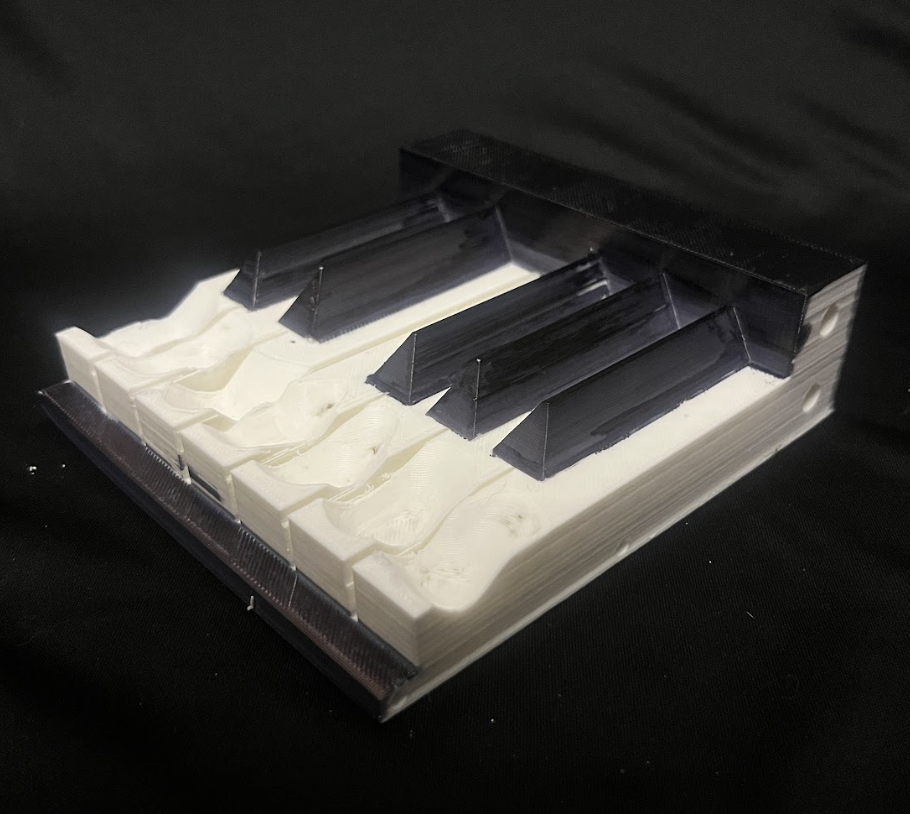My final project explores the intersection of classical music, data visualization, and physical computing through the creation of a tangible data sculpture. The goal was to transform musical data from Chopin’s Etudes (Op. 10) into a physical piano model where each key’s depth represents its frequency of use throughout the compositions. Using computational design and 3D printing, I created a unique visualization that allows viewers to literally feel the patterns in Chopin’s masterpiece through tactile interaction with the keys.



Three projects particularly influenced my approach:
- “Tangible Data Sculpture” by Nathalie Miebach: Her work converting weather data into physical sculptures demonstrated how abstract data could be transformed into meaningful physical forms that engage multiple senses. I was partly inspired by this work earlier this semester, so it was a no-brainer revisiting it for this final project.
- “The Shape of Song” by Martin Wattenberg: While purely digital, this visualization project showing musical patterns through arc diagrams influenced my thinking about representing musical structures in alternative forms.
- “Sound Sculptures” by Realität: Their work transforming sound waves into 3D-printed objects showed me the potential of translating musical elements into physical artifacts.
Process
Data Collection & Analysis
I wrote Python scripts using the mido library to analyze MIDI files of Chopin’s Etudes (Op. 10). The program counts the frequency of each key press, focusing on the C3-B5 range which contains the most musically relevant data. Here’s a sample of the key analysis code:
def analyze_midi_keys(midi_directory):
key_frequencies = defaultdict(int)
for filename in os.listdir(midi_directory):
if filename.endswith('.mid'):
midi_file = MidiFile(midi_path)
for track in midi_file.tracks:
for msg in track:
if msg.type == 'note_on' and msg.velocity > 0:
# Process note data...The data was then scaled logarithmically to create visually meaningful depth variations between 0.5 and 1 inch, ensuring both frequently and rarely played keys would be distinguishable in the final model.

Computational Design
After collecting the frequency data, I developed algorithms to scale the values appropriately for physical representation. The challenge was finding the right balance between showing the data clearly while maintaining structural integrity for 3D printing. I used logarithmic scaling to handle the wide range of frequencies while ensuring even rarely played keys would be visible in the final model.
Fabrication Process
The fabrication process involved several stages:
- Test prints of individual keys to determine optimal printing orientation and settings
- Scaling the data to physical dimensions (0.25″ to 0.5″ depth range)
- Printing of 36 individual keys (C3-B5 range), across three octaves
- Assembly and finishing






Outcome
The final piece consists of 36 keys spanning three octaves (C3-B5), each with a depth corresponding to its frequency in Chopin’s Etudes. The most frequently played keys (particularly in the G3-G5 range) show deeper indentations, creating a visual and tactile representation of Chopin’s compositional patterns.
Key findings from the data:
- Middle register keys (G3-G5) show the highest frequency of use
- Sharp/flat keys generally show lower usage than natural keys
- Certain keys like G4 and A4 stand out with notably high frequencies




Future Work
Given more time, I would expand this project in several ways:
- Include a wider range of Chopin’s works to create a more comprehensive visualization
- Add LED underlighting to create a dynamic visualization that responds to MIDI playback
- Develop a companion digital interface showing real-time data as pieces are played
- Experiment with different materials and finishing techniques to enhance the visual impact
Reflection
This project has given me a deeper appreciation for both the mathematical patterns in Chopin’s compositions and the power of physical data visualization. The process of translating musical data into tangible form revealed patterns that might not be apparent just by listening or reading sheet music. The final piece serves not only as an artistic representation but also as an educational tool for understanding compositional patterns in classical music.
Slides: https://docs.google.com/presentation/d/1TzRCCZ-Z3tlziqXlhNqqeVo9QOYsy3wRvTREtO7fGD4/edit?usp=sharing